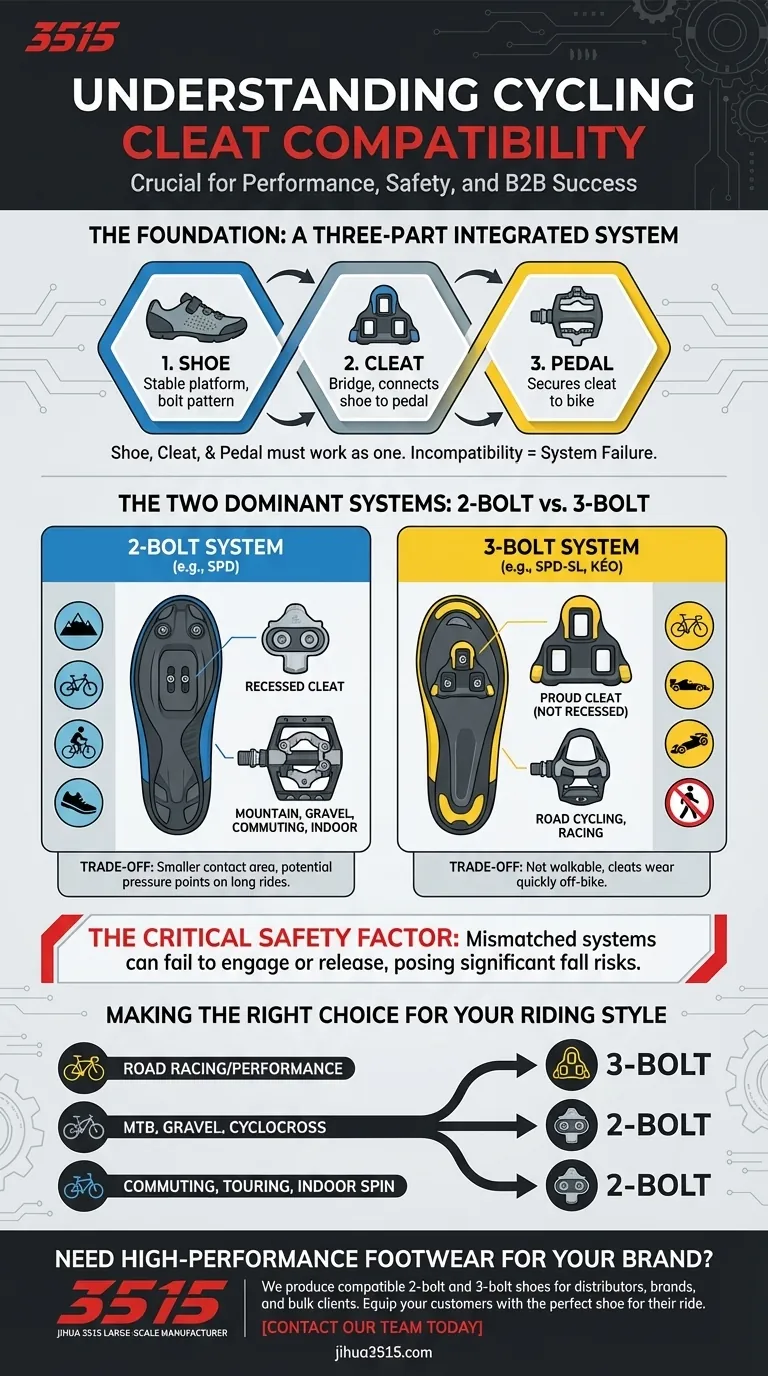At its core, cleat compatibility dictates which type of cleat can be bolted to the bottom of your cycling shoe. This is determined by the bolt-hole pattern on the shoe's sole. Getting this right is non-negotiable, as it ensures your shoes can physically connect to your specific pedals, forming a secure and efficient system.
The central takeaway is that shoe and pedal compatibility is not an interchangeable standard. It is a choice between distinct systems—primarily 2-bolt and 3-bolt—each designed to optimize performance, safety, and practicality for a specific style of cycling.

The Foundation: A Three-Part System
To understand compatibility, you must see your shoes, cleats, and pedals as a single integrated system. All three components must be designed to work together.
The Role of Each Component
The shoe provides the stable platform for your foot and has a specific bolt pattern on the sole.
The cleat is the small metal or plastic piece that acts as the bridge, bolting to the shoe.
The pedal contains the mechanism that the cleat "clips into," securing your foot to the bike.
The Point of Failure
If the shoe's bolt pattern doesn't match the cleat, you cannot attach it. If the cleat doesn't match the pedal's mechanism, you cannot clip in. The entire system fails if one part is incompatible.
The Two Dominant Systems: 2-Bolt vs. 3-Bolt
The cycling world has largely standardized around two primary systems. Your choice between them will be dictated entirely by the type of riding you do.
The 2-Bolt System (e.g., Shimano SPD)
This system is defined by two bolt holes positioned side-by-side on the shoe's sole.
The cleat is typically small and made of metal. Crucially, it is recessed into the shoe's tread, meaning it doesn't make contact with the ground when you walk.
This design is the standard for mountain biking, gravel riding, commuting, and indoor cycling because it allows for easy walking and sheds mud effectively.
The 3-Bolt System (e.g., Shimano SPD-SL, Look KÉO)
This system uses three bolt holes arranged in a triangle.
The cleat is much larger, made of plastic, and sits proud of the shoe's sole. This makes walking awkward and slippery, as you are walking on the cleat itself.
Its advantage is a wide, stable platform that provides excellent power transfer by spreading pressure over a larger area of the foot. This makes it the universal standard for road cycling and racing.
Understanding the Trade-offs
Choosing a system involves accepting a set of compromises designed for a specific purpose. There is no single "best" system, only the right one for your needs.
2-Bolt: Versatility Over Peak Power
The primary benefit of the 2-bolt system is its practicality. The recessed cleat and walkable shoe design are essential for any riding that involves dismounting.
The trade-off is a smaller contact point between the cleat and pedal. For some riders on very long rides, this can create pressure "hot spots" on the foot.
3-Bolt: Performance Over Practicality
The 3-bolt system is single-mindedly focused on performance. The large cleat creates a stiff, stable, and incredibly efficient connection to the pedal.
The obvious downside is the near-total lack of walkability. These shoes are for riding, not walking, and the cleats wear down quickly if you do.
The Critical Safety Factor
Using the wrong combination isn't just inefficient; it's dangerous. A mismatched cleat and pedal can fail to engage properly or, worse, fail to release when you need to unclip, posing a significant risk of falling.
Making the Right Choice for Your Riding Style
Your decision should be based on how and where you ride, not on which system seems technically superior on paper.
- If your primary focus is road racing or performance road cycling: A 3-bolt system is the correct choice for maximum power transfer and stability.
- If your primary focus is mountain biking, gravel, or cyclocross: The walkability and mud-shedding capabilities of a 2-bolt system are non-negotiable.
- If your primary focus is commuting, bike touring, or indoor spin classes: A 2-bolt system offers the versatility and practicality you will need for these activities.
Matching your equipment to your goal ensures every pedal stroke is as safe, comfortable, and efficient as possible.
Summary Table:
| System | Best For | Key Features |
|---|---|---|
| 2-Bolt (e.g., SPD) | Mountain Biking, Gravel, Commuting | Recessed cleat, easy to walk, sheds mud |
| 3-Bolt (e.g., SPD-SL) | Road Cycling, Racing | Large platform, superior power transfer, not walkable |
Need high-performance cycling footwear for your brand or store?
As a large-scale manufacturer, 3515 produces a comprehensive range of cycling shoes and boots for distributors, brand owners, and bulk clients. We can manufacture compatible 2-bolt and 3-bolt shoes designed for safety, comfort, and efficiency. Let us help you equip your customers with the perfect shoe for their ride.
Contact our team today to discuss your production needs!
Visual Guide

Related Products
- Advanced KPU Athletic Safety Shoe with Steel Toe Cap Anti-Slip Rotary Lacing System
- Wholesale Lightweight Cushioned Athletic Sneakers for Custom Bulk Production
- Premium Grain Leather Safety Boots for Bulk Supply
- Premium Wholesale Waterproof Safety Boots High Performance Protection for Industrial Markets
- Heavy-Duty Waterproof Nubuck Safety Boots Safety Shoes for Bulk Supply
People Also Ask
- How do safety boots reduce cutting hazards? Essential Protection for Your Workforce
- Why is it important to select breathable and supportive materials for work boot uppers? Enhance Safety and Comfort
- What does the infographic mentioned in the article cover? Prevent Workplace Foot Injuries with the Right Safety Footwear
- What factors should be checked when trying on safety shoes? Ensure Perfect Fit & Maximum Protection
- What is the significance of composite or steel toe protection in work boots? Ensure Maximum Foot Safety & Comfort



















